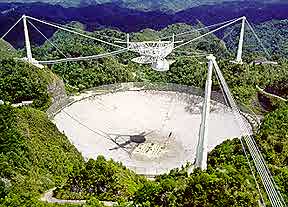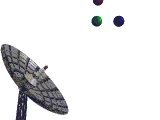
A radar telescope is essentially
a radio telescope with the addition of a transmitter. Although there
are many radio
telescopes, there are pretty much only two radar telescopes in the
world today that can produce useful delay-Doppler images of asteroids.
They are ...
| The Goldstone Solar System Radar is part of NASA's Deep Space Network. Located near Barstow California, the largest dish is the fully-steerable, 70 meter DSS-14 (shown foreground at right). This system can transmit 500 kW at 8510 MHz (3.5 cm). Reception can be performed at DSS-14 or at DSS-13 (shown background at right). This allows bistatic operation where transmission (at DSS-14) and reception (at DSS-13) is continuous. |  |
|
|
|
 |
The Arecibo Radar Telescope is operated by the NAIC. This fixed-dish, 300 meter antenna is located near Arecibo, Puerto Rico. It can transmit 1 MW at 2380 MHz (12.6 cm). It has primarily operated in a monostatic mode (switching between transmit and receive) but bistatic operation with the NRAO's Greenbank antenna is possible. |
|
|
Radar studies of asteroids began with the detection of 1566 Icarus in 1968, but delay-Doppler imaging with enough resolution to perform detailed physical modeling first occurred in 1989 when a team led by Steven Ostro of the Jet Propulsion Laboratory used the Arecibo radar to image 4769 Castalia.
Think of a radar transmitter as
shooting out a bunch of green balls.  These
balls are chucks of radio-wave energy called photons.
These
balls are chucks of radio-wave energy called photons.  We're
going to show just a few photons but a real planetary radar system sends
out a HUGE number - as many as a million trillion trillion photons every
second! The balls travel millions of miles through space until they
encounter the asteroid. Different balls will hit the asteroid in different
places. Since some parts of the asteroid are nearer to the radar than other
parts, the balls will get reflected at different times.Since the asteroid
is spinning, some parts of the surface are moving towards the radar and
some parts are moving away.
We're
going to show just a few photons but a real planetary radar system sends
out a HUGE number - as many as a million trillion trillion photons every
second! The balls travel millions of miles through space until they
encounter the asteroid. Different balls will hit the asteroid in different
places. Since some parts of the asteroid are nearer to the radar than other
parts, the balls will get reflected at different times.Since the asteroid
is spinning, some parts of the surface are moving towards the radar and
some parts are moving away.  Balls
that hit the parts moving away get stretched a little (shown as turning
red in the animation) while those that hit the parts moving towards the
radar get scrunched (turn blue). The balls,
with different delays and different colors return to the antenna.
Balls
that hit the parts moving away get stretched a little (shown as turning
red in the animation) while those that hit the parts moving towards the
radar get scrunched (turn blue). The balls,
with different delays and different colors return to the antenna.